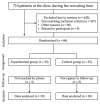Can Teledentistry Replace Conventional Clinical Follow-Up Care for Minor Dental Surgery? A Prospective Randomized Clinical Trial
- PMID: 35329133
- PMCID: PMC8953526
- DOI: 10.3390/ijerph19063444
Can Teledentistry Replace Conventional Clinical Follow-Up Care for Minor Dental Surgery? A Prospective Randomized Clinical Trial
Abstract
(1) Background: Born out of necessity, the implementation of digital processes experienced significant increase during the COVID-19 pandemic. Here, telemedicine offered a bridge to care and now an opportunity to reinvent virtual and hybrid care models, with the goal of improved healthcare access, outcomes, and affordability. The aim of this monocentric prospective, randomized trial was to compare conventional to telephone follow-up after minor dentoalveolar surgery on the basis of special aftercare questionnaires. (2) Methods: Sixty patients who underwent dentoalveolar surgery under local anesthesia were randomly assigned to both groups. After an average of four days, either telephone follow-up (test) or conventional personal aftercare (control) was performed. Based on the questionnaire, the following subject areas were evaluated: symptoms, complications, satisfaction with practitioner, travel, and waiting time, as well as the preferred form of follow-up care. (3) Results: There was no statistically significant difference regarding frequency of symptoms or complication rate. Patients who were assigned to the test group showed a clear tendency to prefer telephone follow-up (83.3%) to conventional aftercare (16.7%, p = 0.047). (4) Conclusions: The data suggest high acceptance of telephone-only follow-up after dentoalveolar surgery. The implementation of telemedicine could be a time- and money-saving alternative for both patients and healthcare professionals and provide healthcare access regardless of time and space.
Keywords: follow-up; oral health; oral surgery; teledentistry; telemedicine.
Conflict of interest statement
The authors declare no conflict of interest.
Figures






Similar articles
-
Text Messaging, Telephone, or In-Person Outpatient Visit to the Surgical Clinic: A Randomized Trial.J Surg Res. 2022 Dec;280:226-233. doi: 10.1016/j.jss.2022.07.013. Epub 2022 Aug 22. J Surg Res. 2022. PMID: 36007481 Free PMC article. Clinical Trial.
-
After dentoalveolar surgery, most patients are satisfied with telephone follow-up.J Oral Maxillofac Surg. 2011 Aug;69(8):2099-105. doi: 10.1016/j.joms.2010.12.013. Epub 2011 Jun 15. J Oral Maxillofac Surg. 2011. PMID: 21680076
-
Experiences of patients and health care professionals on the quality of telephone follow-up care during the COVID-19 pandemic: a large qualitative study in a multidisciplinary academic setting.BMJ Open. 2022 Mar 10;12(3):e058361. doi: 10.1136/bmjopen-2021-058361. BMJ Open. 2022. PMID: 35273062 Free PMC article.
-
Teledentistry during COVID-19 pandemic: scientometric and content analysis approach.BMC Health Serv Res. 2022 Sep 1;22(1):1111. doi: 10.1186/s12913-022-08488-z. BMC Health Serv Res. 2022. PMID: 36050678 Free PMC article. Review.
-
Teledentistry during COVID-19 pandemic.Diabetes Metab Syndr. 2020 Sep-Oct;14(5):933-935. doi: 10.1016/j.dsx.2020.06.029. Epub 2020 Jun 16. Diabetes Metab Syndr. 2020. PMID: 32593116 Free PMC article. Review.
Cited by
-
Patient views on the effectiveness of audio-dentistry for emergency triage during COVID-19.Qatar Med J. 2025 Feb 26;2025(1):13. doi: 10.5339/qmj.2025.13. eCollection 2025. Qatar Med J. 2025. PMID: 40395365 Free PMC article.
-
Relevance of Teledentistry: Brief Report and Future Perspectives.Front Dent. 2022 Aug 5;19:25. doi: 10.18502/fid.v19i25.10596. eCollection 2022. Front Dent. 2022. PMID: 36458271 Free PMC article. Review.
References
-
- WHO . A Health Telematics Policy in Support of WHO’S Health-For-All Strategy for Global Development: Report of the WHO Group Consultation on Health Telematics 11–16 December, Geneva, 1997. World Health Organization; Geneva, Switzerland: 1998.
-
- WHO Telemedicine: Opportunities and Developments in Member States: Report on the Second Global Survey on eHealth 2009. Healthc. Inform. Res. 2012;18:153–155. doi: 10.4258/hir.2012.18.2.153. - DOI
-
- Thompson J.C., Cichowski S.B., Rogers R.G., Qeadan F., Zambrano J., Wenzl C., Jeppson P.C., Dunivan G.C., Komesu Y.M. Outpatient visits versus telephone interviews for postoperative care: A randomized controlled trial. Int. Urogynecol. J. 2019;30:1639–1646. doi: 10.1007/s00192-019-03895-z. - DOI - PMC - PubMed
Publication types
MeSH terms
LinkOut - more resources
Full Text Sources
Medical

